TRON has not only achieved a historic reduction of up to 60% in Gas fees but has also introduced a quarterly dynamic adjustment mechanism.
At the end of August, the TRON network reached an important milestone in its development history: not only achieving a historic reduction of up to 60% in Gas fees but also introducing a quarterly dynamic adjustment mechanism. This is the largest fee optimization since the TRON mainnet launched in 2018.
This Gas fee reduction is not merely a simple adjustment of price parameters; it resembles a deep reform themed around "benefiting users and activating the ecosystem," marking an important strategic upgrade for the development of the TRON ecosystem.
By lowering fees, TRON has significantly reduced the cost of network participation, releasing its value from both the "users" and "developers" sides: for users, the single transaction cost for on-chain transactions and DApp interactions can be reduced by nearly 60%, effectively stimulating potential high-frequency trading demand and attracting a massive influx of new users into the ecosystem with a "low threshold"; for Web3 developers, the long-term costs of deploying smart contracts and operating DApps will be significantly reduced, creating a more favorable entrepreneurial environment with notable cost advantages, encouraging more innovative teams to deploy DApps on the TRON network and explore new tracks, further enriching the ecosystem application matrix.
It is foreseeable that this initiative will bring multiple positive effects to TRON: not only will users genuinely enjoy a "low-cost, high-convenience" network experience, but it will also inject new growth vitality into the entire ecosystem, driving exponential growth in user activity and transaction volume, thereby forming a virtuous cycle of "lowering thresholds → increasing activity → promoting development," laying the foundation for the sustainable prosperity of the TRON ecosystem.
For the TRON ecosystem, this significant reduction in Gas fees is of profound significance. It will not only bring immediate cost advantages to existing DApps within the ecosystem, but its positive impact will also permeate every corner of the ecosystem. Various DApp applications will benefit from this transformation, and with the reduction in costs, they will have more resources and motivation to innovate and develop, collectively accelerating the pace of innovation in the TRON ecosystem and pushing the entire ecosystem towards a more prosperous future.
As transaction costs are significantly reduced, the flow of funds in DeFi protocols will become smoother and more efficient, greatly enhancing the efficiency and liquidity of fund usage; the NFT sector and creator economy will also welcome new development opportunities, as the reduction in creation, minting, and transaction cost thresholds will stimulate greater innovative enthusiasm among creators, unleashing a continuous stream of innovative vitality; while cutting-edge fields like Meme will have the fertile soil of "low-cost trial and error," allowing for bolder exploration and attempts, accelerating the landing and rooting of new application categories, and continuously expanding the user base.
Double impact! TRON Gas fees drop by 60%, simultaneously introducing a quarterly dynamic adjustment mechanism
"The on-chain Gas fee not only drops by 60% but will also introduce a quarterly dynamic adjustment mechanism," is the latest measure taken by the TRON network to optimize its on-chain fee mechanism. This means that the TRON network's transaction fees will bid farewell to the era of "fixed and unchanging," with flexible adjustments possible every quarter based on actual market conditions in the future.
In the blockchain world, Gas fees are akin to "highway tolls" in reality, directly determining users' willingness and frequency of transactions: excessively high fees not only increase the burden on users but also create entry barriers, shutting out potential users and stifling the innovative vitality of the ecosystem; while reasonable and low fees can significantly lower participation thresholds, attracting more users to enter and providing the soil for the prosperity of the DApp ecosystem.
As the world's largest stablecoin network, TRON has always been known for its core advantages of "low fees, high security, and high efficiency," but as the price of TRX rises, the actual transaction costs on-chain have gradually increased, leading to a rise in network transaction fees.
TRON founder Justin Sun has always placed great importance on network fee issues. As early as July, he stated on the X platform: with the continuous rise in TRX prices, the TRON community would adopt various measures to lower network Gas fees, whether by reducing energy unit prices, increasing energy caps, or encouraging energy staking. On August 21, he reiterated: TRON super representatives have been paying attention to the issue of "fee increases accompanying TRX price rises," and the community will flexibly adjust rates based on actual conditions to ensure network competitiveness.
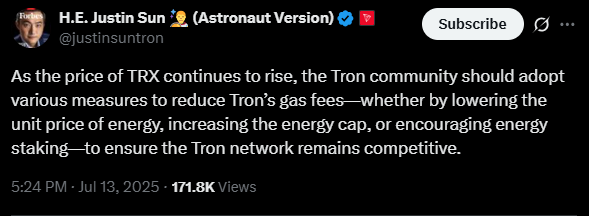
Soon, this plan was implemented into concrete action: on August 26, TRON super node representatives (SR) initiated Proposal No. 104, proposing to "reduce the network energy unit price from 0.00021 TRX (210 SUN) to 0.0001 TRX (100 SUN)." This adjustment will directly reduce the TRX burning cost for on-chain transactions by nearly 60%, effectively relieving the burden on users and developers, further activating ecosystem activity. On August 29, the proposal was passed with a high vote, with 25 out of 27 super node representatives voting in favor. On the same day, the TRON network energy unit price was officially lowered, meaning that previously, 0.00021 TRX was needed to burn to obtain 1 unit of energy, but now only 0.0001 TRX is required.
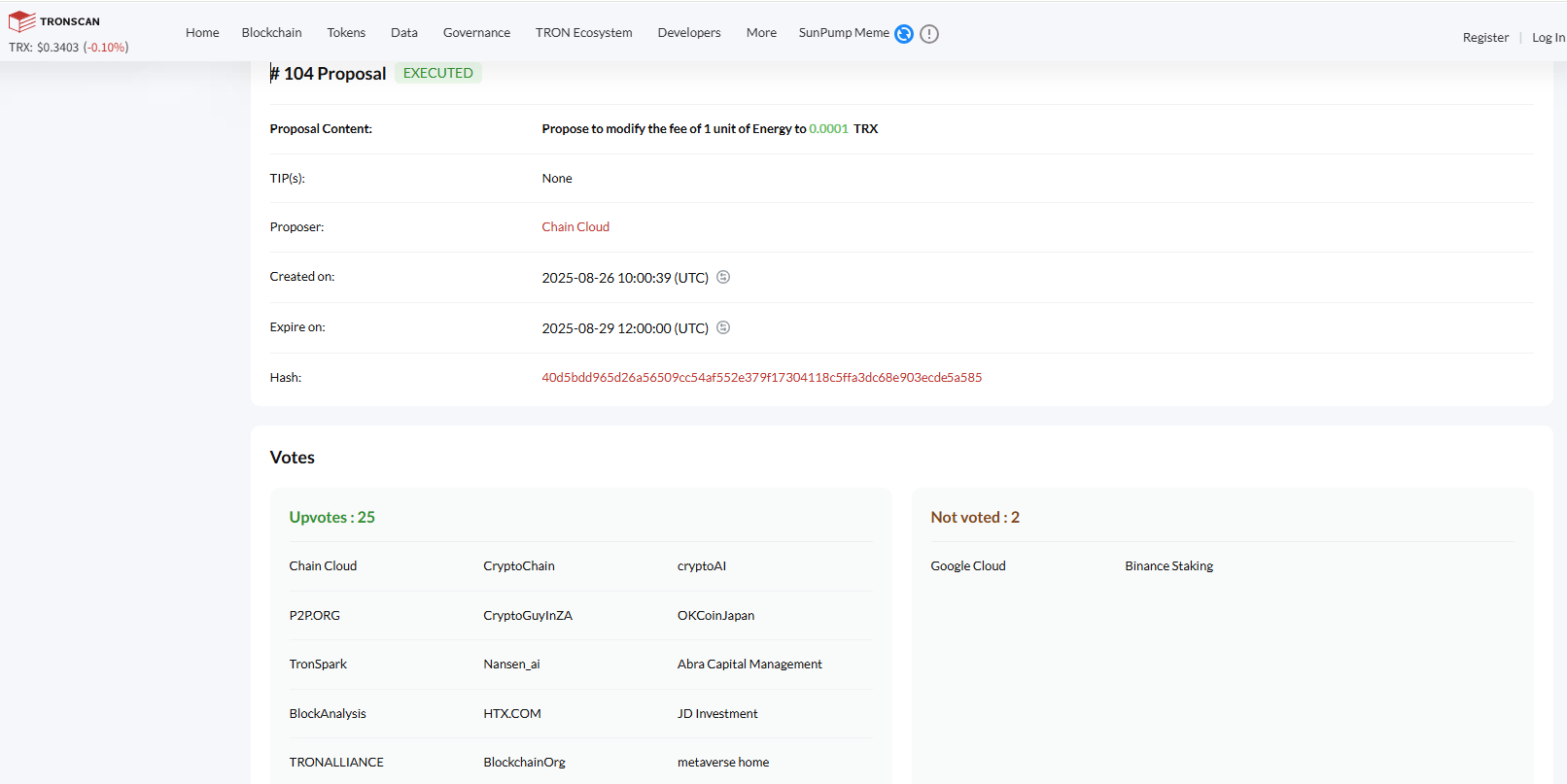
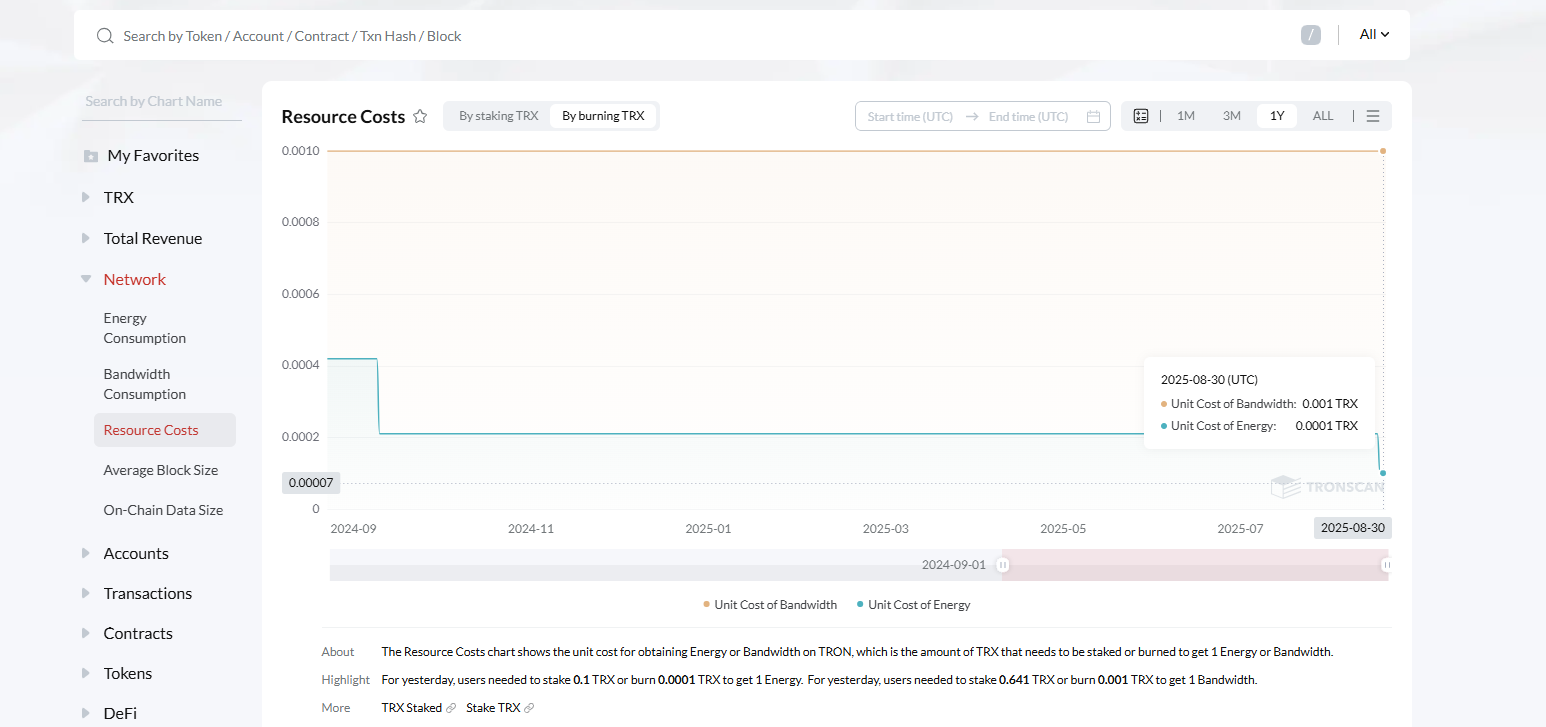
To understand the core value of this adjustment, one must first clarify the composition of the TRON network's transaction fees: on-chain transaction fees mainly rely on Bandwidth and Energy resources. Bandwidth is used to measure the storage and network resources occupied by transactions, while Energy is used to calculate the computing power required for executing smart contracts (such as DeFi logical operations). Previously, each account on the TRON chain would receive a certain amount of free bandwidth daily, and the price for each unit of bandwidth had always been 0.001 TRX; the Energy part, however, is dynamically changing, and users can obtain Energy by staking TRX. If the wallet's Energy is insufficient, TRX must be burned to supplement it.
Energy, as a key resource for executing smart contracts and calling contract logic (such as DeFi lending calculations, NFT minting rights confirmation, and Meme token transfers) on the TRON network, directly determines the cost for users to operate on-chain DApps. The reduction of the Energy unit price from 0.00021 TRX to 0.0001 TRX means that the TRX cost consumed by users when executing the aforementioned operations is directly reduced by nearly 60%, directly corresponding to the reduction in "core Gas fee costs," thus being regarded as a "Gas fee drop of about 60%." For a typical NFT minting, for example, previously 0.21 TRX was needed to burn to obtain 10,000 units of Energy, but now only 0.1 TRX is required, making the cost reduction evident.
The decrease in Energy prices is particularly friendly to two types of users. For high-frequency trading users (such as those participating in DeFi arbitrage multiple times a day, GameFi players, etc.), long-term operational costs can be reduced by nearly 60%, allowing them to trade and operate more freely on-chain; for small payment users (such as cross-border transfers, daily consumption scenarios), there is no longer hesitation over "transaction fees exceeding the transaction amount," truly achieving "low-cost high-frequency use," making on-chain payments more widespread and convenient.
More importantly, the TRON on-chain fees will also introduce a quarterly dynamic observation adjustment mechanism. This means that TRON network transaction fees will no longer be fixed, but will be flexibly optimized every quarter based on core indicators such as TRX market price, network activity, and user growth rate.
Regarding this adjustment, TRON founder Justin Sun summarized: the 60% fee reduction is rare in the industry and is a real benefit for users; in the short term, network revenue may be affected, but in the long term, it will gain stronger profit potential due to user and transaction volume growth; in the future, TRON super representatives will dynamically assess rates quarterly, balancing competition and profitability based on multiple indicators.
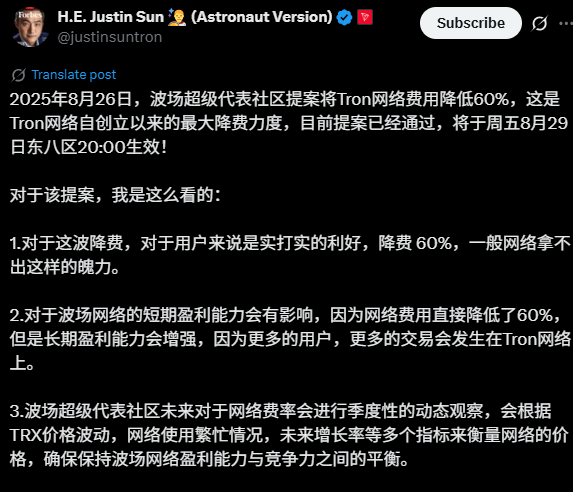
This decision has received widespread recognition from industry professionals. It is generally believed that this fee reduction will lower the TRX burning cost for on-chain transactions by more than half, bringing multiple benefits to the ecosystem. For developers, the cost burden of contract deployment and application operation will be significantly reduced; for users, the thresholds and costs for transfers and DApp interactions will be greatly lowered; in the long run, low fees will attract more new users, further promoting the ecological expansion of TRON in DeFi, stablecoins, Meme, and other sectors.
Crypto KOL @May posted on the X platform: "For users, the costs of on-chain transfers, contract deployments, and participating in DeFi interactions on TRON will significantly decrease. This proactive fee reduction not only alleviates the burden of use but also solidifies TRON's advantage in the high-frequency small payment field. Low costs encourage developers to explore new applications, and users are more willing to use TRON in daily scenarios."
Thus, TRON has not only achieved the short-term benefits of "Energy unit price as low as 0.0001 TRX and Gas fees dropping by 60%" but has also established a scientific and flexible fee adjustment system, giving TRON's fee structure "long-term adaptability." This dynamic mechanism not only avoids the problem of "TRX price increases leading to passive fee hikes" but also prevents the risk of "too low rates affecting network sustainability," finding the best balance between "user benefits" and "ecosystem profitability," allowing TRON to maintain a friendly stance towards developers and users, injecting strong momentum for the long-term prosperity of the ecosystem.
DApp interaction costs significantly reduced, TRON ecosystem welcomes new growth opportunities
The historic reduction in Gas fees on the TRON network is injecting unprecedented growth vitality into the entire ecosystem. The significant reduction in on-chain transaction costs can not only activate potential high-frequency trading demand but also attract a massive influx of new users with a "low threshold"; at the same time, this cost dividend is rapidly permeating various DApps within the ecosystem, covering multiple core sectors such as DeFi, NFT, stablecoins, and Meme, bringing comprehensive growth to the TRON ecosystem.
From the one-stop DEX platform SUN.io that meets mainstream trading needs, to the lending center JustLend DAO that supports capital circulation; from the NFT trading platform APENFT that provides digital art circulation services, to the Meme issuance platform SunPump that supports community innovation, and the stablecoin circulation system covering daily payment scenarios, all benefit from this fee reduction. Almost all applications on the TRON chain can leverage lower energy costs to optimize user experience, thereby enhancing user retention and activity, allowing users to experience real convenience and affordability during use, thus promoting the entire ecosystem to form a positive cycle of "cost reduction → user activity → ecosystem prosperity."
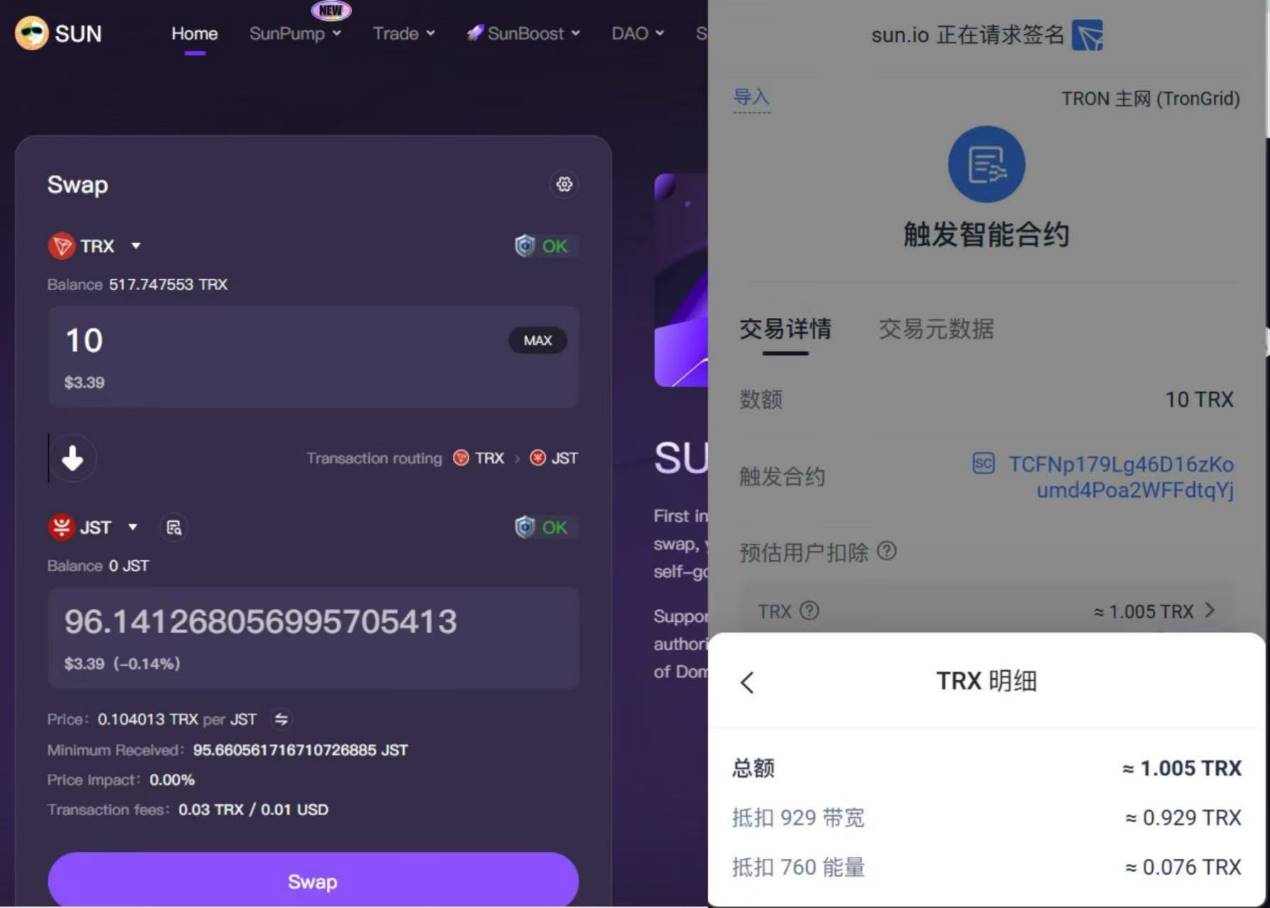
Gas fees required for each transaction on Sun.io as of September 2
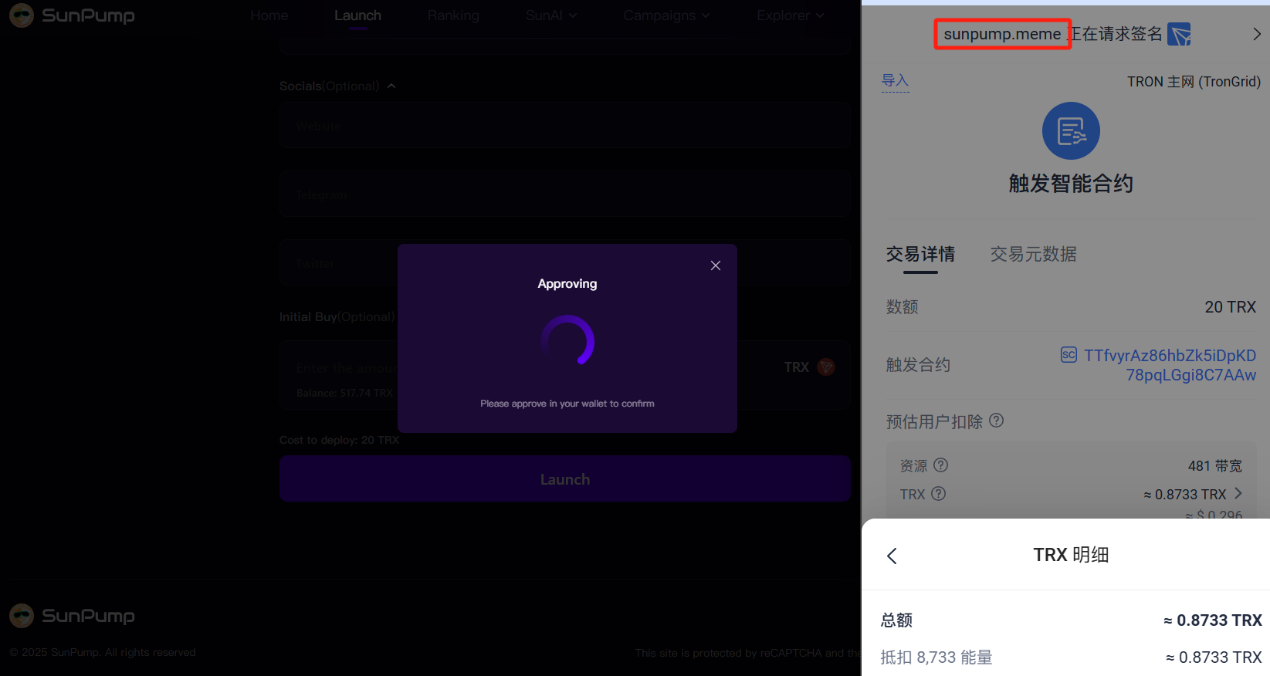
Gas fees required for creating Meme coins on SunPump as of September 2
The impact of the fee reduction is already spreading. On September 1, the lending platform JustLend DAO was the first to respond, announcing a reduction in its basic tax rate for the Energy Rental platform from 15% to 8%. This move further lowers the cost for users to acquire energy, allowing more people to easily participate in on-chain operations. Currently, the energy price on JustLend DAO is approximately 26 sun/Day, and users only need to use 2.62 TRX to rent 100,000 energy (equivalent to the energy obtained by staking 9986 TRX), which is sufficient to meet the needs of two transactions. This means that users utilizing the Energy Rental platform on JustLend DAO for on-chain transactions will enjoy double benefits: one from the reduced energy price and the other from the benefits of energy rental itself.
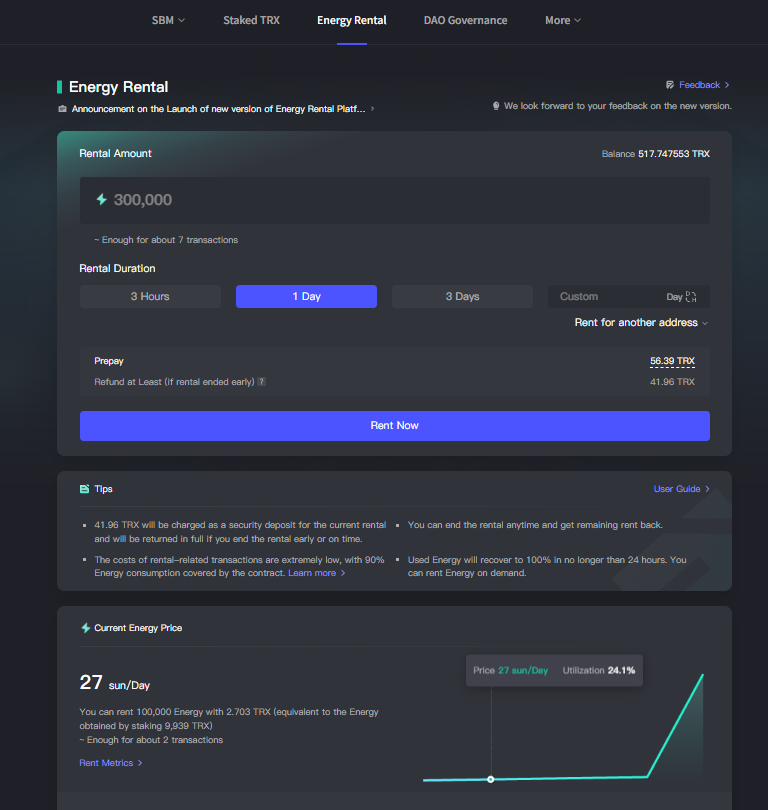
From a segmented perspective, the logic of benefits and growth potential in various fields is becoming clearer.
In the stablecoin payment sector, TRON, as the world's largest USDT circulation network (with an on-chain USDT issuance exceeding $82.6 billion), will see a significant reduction in costs for cross-border payments and small transfers, promoting stablecoins to penetrate daily consumption scenarios more deeply and further consolidating its core position as a "global stablecoin settlement network." For example, Southeast Asian cross-border e-commerce merchants using TRC20 USDT for payments may see the transfer fee for each $100 transaction drop from approximately 0.21 TRX to 0.1 TRX, halving the cost and encouraging more merchants to incorporate TRON stablecoins into their payment systems, accelerating the penetration of stablecoins into the real economy and injecting new vitality into its development.
For DeFi protocols within the TRON ecosystem, the reduction in operational costs for trading, lending, and staking allows users to participate more flexibly in arbitrage and adjust funding strategies, especially for high-frequency cross-pool arbitrage operations. Currently, the TRON ecosystem has formed a DeFi matrix centered around the one-stop DEX SUN.io and the lending platform JustLend DAO, and the reduction in trading costs is expected to directly drive a dual growth in transaction frequency and capital scale for these two major platforms, promoting a more prosperous DeFi ecosystem.
In the NFT sector, the reduction in costs for minting, listing, and trading NFTs will directly activate the vitality of both creators and collectors. For creators, the reduction in minting costs lowers the participation threshold for NFTs, making it easier for small and medium creators to unleash their creativity; for collectors, the reduced fees for bidding and reselling NFTs will increase transaction frequency, driving growth in trading volume on the APENFT platform and pushing the digital art ecosystem from niche circles to the mass market.
Regarding Meme and creator economy aspects, the lowered thresholds for community projects to issue tokens and for creators to monetize through on-chain tools will stimulate more innovative gameplay. For instance, individual creators can use the SunPump platform to issue exclusive Meme tokens at a lower cost or initiate on-chain crowdfunding; communities can achieve "token airdrops and community incentives" through low-cost transfers, promoting on-chain cultural dissemination and the development of the social economy, leading to an increase in the number of new Meme projects.
Historical data more intuitively confirms the strong driving effect of fee reductions on the ecosystem. In September last year, after TRON executed Proposal No. 95, reducing the price of each unit of energy from 0.00042 TRX to 0.00021 TRX, data from TRONSCAN showed that within three months, the number of daily active accounts on the TRON network grew by 27%, and total transaction volume increased by 19%. Subsequently, the newly launched SunPump platform within the TRON ecosystem sparked a Meme craze, with the on-chain USDT scale surpassing Ethereum, officially becoming the world's largest stablecoin circulation network.
Now, with energy prices dropping by nearly 60%, marking the largest adjustment since the mainnet launch in 2018, the growth potential of the TRON ecosystem is even more promising. From the data, the "immediate effects" of growth in the TRON ecosystem have begun to emerge. According to DeFiLlama data, on September 1, the number of active addresses on the TRON network reached 2.48 million within 24 hours, ranking first among all public chain networks. According to TRONSCAN, the total number of transactions completed on the TRON network that day reached 9.55 million, with contract calls reaching as high as 2.57 million, setting a new record since June of this year, reflecting a significant increase in users' willingness to interact with DApps and showcasing a robust development trend in the ecosystem.
At the same time, the TRON ecosystem has been making continuous efforts and recently welcomed several key developments. The wallet with the largest global user base, MetaMask, announced support for integrating the TRON network, allowing users to directly trade TRON ecosystem assets or use ecosystem DApps like SUN.io and APENFT through this mainstream wallet, significantly lowering the barriers for cross-ecosystem user migration and enabling more users to easily enter the TRON ecosystem; the cross-chain protocol DeBrige has supported the TRON network, opening up value transfer channels with other public chains; additionally, TRON has partnered with the compliant exchange Kraken and the tokenized finance platform BackedFi to integrate the tokenized stock platform xStocks into the network, creating a new scenario for ecosystem users to "invest in traditional financial assets on-chain," further enriching the boundaries of ecosystem applications and providing users with more diversified investment options.
This reduction in Gas fees, combined with favorable developments in the ecosystem, creates a multiple resonance effect, collectively building a stronger growth moat for TRON: on one hand, low fees continue to attract users and developers, providing fertile ground for "low-cost trial and error, high innovation space" in fields such as DeFi, AI, NFT, Meme, SocialFi, and GameFi; on the other hand, upgrades in foundational capabilities such as wallet integration, cross-chain interoperability, and compliant asset access address users' pain points of "difficult entry, difficult circulation, and few scenarios," forming a virtuous cycle of "low threshold attraction → good experience retention → multi-scenario conversion," promoting the sustainable and healthy development of the ecosystem.
In the future, TRON will continue to consolidate its "cost advantages + ecological barriers," leading the Web3 ecosystem towards a more inclusive, active, and creative direction.
免责声明:本文章仅代表作者个人观点,不代表本平台的立场和观点。本文章仅供信息分享,不构成对任何人的任何投资建议。用户与作者之间的任何争议,与本平台无关。如网页中刊载的文章或图片涉及侵权,请提供相关的权利证明和身份证明发送邮件到support@aicoin.com,本平台相关工作人员将会进行核查。




